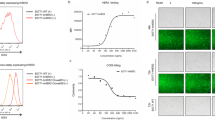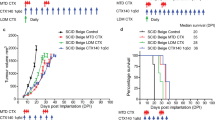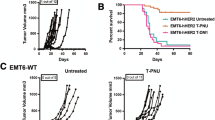Abstract
Human epidermal growth factor receptor type 2 (HER2)-positive breast cancer that is treated with anti-HER2/neu monoclonal antibody (mAb) is not free from late recurrences. Addition of anti-4-1BB mAb to anti-HER2/neu mAb has been demonstrated to strengthen the cytotoxic antitumor response. Our study expands on this by revealing the influence of anti-4-1BB mAb addition on the immune memory of anti-HER2/neu mAb. We designed murine breast cancer models by implanting TUBO and TUBO-P2J cell lines in mice, which were then treated with anti-HER2/neu and/or anti-4-1BB mAb. After complete surgical and/or chemical regression of the tumor, the mice were rechallenged with a second injection of cancer cells. Notably, anti-HER2/neu and anti-4-1BB mAb combination therapy had a synergistic antitumor effect at the initial treatment. However, the combination therapy did not evoke immune memory, allowing the tumors to thrive at rechallenge with reduced CD44+ expression in CD8+ T cells. Immune memory was also impaired when anti-4-1BB mAb was administered to naive CD8+ T cells but was sustained when this was administered to activated CD8+ T cells. In an attempt to resist the loss of immune memory, we controlled the dose of anti-4-1BB mAb to optimize the stimulation of activated CD8+ T cells. Immune memory was achieved with the dose regulation of anti-4-1BB mAb to 1 mg/kg in our model. Our study demonstrates the importance in understanding the adaptive immune mechanism of anti-HER2/neu and anti-4-1BB mAb combination therapy and suggests a dose optimization strategy is necessary to ensure development of successful immune memory.




Similar content being viewed by others
Availability of data and materials
All data generated or analyzed during this study are included in this published article.
References
Hudis CA (2007) Trastuzumab–mechanism of action and use in clinical practice. N Engl J Med 357(1):39–51
Clynes RA et al (2000) Inhibitory Fc receptors modulate in vivo cytotoxicity against tumor targets. Nat Med 6(4):443–446
Park S et al (2010) The therapeutic effect of anti-HER2/neu antibody depends on both innate and adaptive immunity. Cancer Cell 18(2):160–170
Cameron D et al (2017) 11 years’ follow-up of trastuzumab after adjuvant chemotherapy in HER2-positive early breast cancer: final analysis of the HERceptin Adjuvant (HERA) trial. Lancet 389(10075):1195–1205
Watts TH (2005) TNF/TNFR family members in costimulation of T cell responses. Annu Rev Immunol 23:23–68
Melero I et al (1997) Monoclonal antibodies against the 4–1BB T-cell activation molecule eradicate established tumors. Nat Med 3(6):682–685
Takahashi C et al (1999) Cutting edge: 4–1BB is a bona fide CD8 T cell survival signal. J Immunol 162(9):5037–5040
Stagg J et al (2011) Anti-ErbB-2 mAb therapy requires type I and II interferons and synergizes with anti-PD-1 or anti-CD137 mAb therapy. Proc Natl Acad Sci USA 108(17):7142–7147
Song H et al (2014) Intratumoral heterogeneity impacts the response to anti-neu antibody therapy. BMC Cancer 14:647
Kang SW et al (2017) Anti-CD137 Suppresses Tumor Growth by Blocking Reverse Signaling by CD137 Ligand. Cancer Res 77(21):5989–6000
Masu T et al (2018) Anti-CD137 monoclonal antibody enhances trastuzumab-induced, natural killer cell-mediated cytotoxicity against pancreatic cancer cell lines with low human epidermal growth factor-like receptor 2 expression. PLoS ONE 13(12):e0200664
Sallusto F et al (1999) Two subsets of memory T lymphocytes with distinct homing potentials and effector functions. Nature 401(6754):708–712
Moasser MM (2007) Targeting the function of the HER2 oncogene in human cancer therapeutics. Oncogene 26(46):6577–6592
Kiessling R et al (2002) Cellular immunity to the Her-2/neu protooncogene. Adv Cancer Res 85:101–144
Le XF et al (2005) Genes affecting the cell cycle, growth, maintenance, and drug sensitivity are preferentially regulated by anti-HER2 antibody through phosphatidylinositol 3-kinase-AKT signaling. J Biol Chem 280(3):2092–2104
Mittendorf EA et al (2010) A novel interaction between HER2/neu and cyclin E in breast cancer. Oncogene 29(27):3896–3907
Pegram M et al (1999) Inhibitory effects of combinations of HER-2/neu antibody and chemotherapeutic agents used for treatment of human breast cancers. Oncogene 18(13):2241–2251
Clynes RA et al (2000) Inhibitory Fc receptors modulate in vivo cytoxicity against tumor targets. Nat Med 6(4):443–446
Musolino A et al (2008) Immunoglobulin G fragment C receptor polymorphisms and clinical efficacy of trastuzumab-based therapy in patients with HER-2/neu-positive metastatic breast cancer. J Clin Oncol 26(11):1789–1796
Arnould L et al (2006) Trastuzumab-based treatment of HER2-positive breast cancer: an antibody-dependent cellular cytotoxicity mechanism? Br J Cancer 94(2):259–267
Varchetta S et al (2007) Elements related to heterogeneity of antibody-dependent cell cytotoxicity in patients under trastuzumab therapy for primary operable breast cancer overexpressing Her2. Cancer Res 67(24):11991–11999
Gennari R et al (2004) Pilot study of the mechanism of action of preoperative trastuzumab in patients with primary operable breast tumors overexpressing HER2. Clin Cancer Res 10(17):5650–5655
Ladjemi MZ et al (2010) Anti-HER2 vaccines: new prospects for breast cancer therapy. Cancer Immunol Immunother 59(9):1295–1312
Wang W et al (2015) NK cell-mediated antibody-dependent cellular cytotoxicity in cancer immunotherapy. Front Immunol 6:368
Chester C et al (2016) 4–1BB agonism: adding the accelerator to cancer immunotherapy. Cancer Immunol Immunother 65(10):1243–1248
Dranoff G (2004) Cytokines in cancer pathogenesis and cancer therapy. Nat Rev Cancer 4(1):11–22
Topalian SL et al (2016) Mechanism-driven biomarkers to guide immune checkpoint blockade in cancer therapy. Nat Rev Cancer 16(5):275–287
Farhood B et al (2019) CD8(+) cytotoxic T lymphocytes in cancer immunotherapy: A review. J Cell Physiol 234(6):8509–8521
Etxeberria I et al (2020) New emerging targets in cancer immunotherapy: CD137/4–1BB costimulatory axis. ESMO Open 4(Suppl 3):e000733
Ahmadzadeh M et al (2009) (2009) Tumor antigen-specific CD8 T cells infiltrating the tumor express high levels of PD-1 and are functionally impaired. Blood 114(8):1537–1544
Miller BC et al (2019) Subsets of exhausted CD8(þ) T cells differentially mediate tumor control and respond to checkpoint blockade. Nat Immunol 20(3):326–336
Paley MA et al (2012) Progenitor and terminal subsets of CD8þ T cells cooperate to contain chronic viral infection. Science 338(6111):1220–1225
Krasniqi E et al (2019) Immunotherapy in HER2-positive breast cancer: state of the art and future perspectives. J Hematol Oncol 12(1):111
Funding
This work was supported by the Bio & Medical Technology Development Program of the National Research Foundation (NRF) of Korea funded by the Korean Government (MSIT) Under Grant (No.2019M3A9H1103607); Under Grant (No.2017R1C1B5076247); Under Grant (No.2016R1D1A1B03935426); and the SAMJINPHARM.CO., LTD Under Grant (SJ-IIT-17-07).
Author information
Authors and Affiliations
Contributions
HYK, J-HC and SGP conceptualized the study and reviewed the writing of the manuscript. HYK, J-HC and MMH wrote the original draft of the manuscript and analyzed the data. JHP, I-HK and BKC investigated the immune cell population and activity. AL and SGP were involved in supervision, funding acquisition and project administration.
Corresponding authors
Ethics declarations
Conflict of interest
The researcher claims no conflicts of interest.
Ethics approval and consent to participate
The experimental procedures were reviewed and approved by the Institutional Animal Care and Use Committee of Inje University (2019-002).
Consent for publication
I would like to declare that the manuscript is approved by all authors for publication.
Additional information
Publisher's Note
Springer Nature remains neutral with regard to jurisdictional claims in published maps and institutional affiliations.
Rights and permissions
About this article
Cite this article
Kim, H.Y., Choi, JH., Haque, M.M. et al. Combined treatment with anti-HER2/neu and anti-4-1BB monoclonal antibodies induces a synergistic antitumor effect but requires dose optimization to maintain immune memory for protection from lethal rechallenge. Cancer Immunol Immunother 71, 967–978 (2022). https://doi.org/10.1007/s00262-021-03120-1
Received:
Accepted:
Published:
Issue Date:
DOI: https://doi.org/10.1007/s00262-021-03120-1




